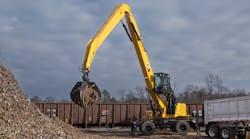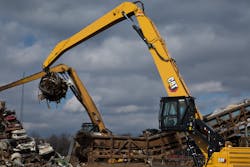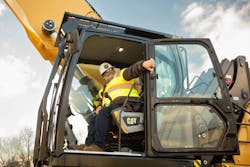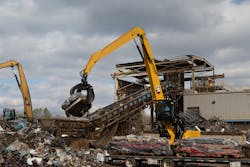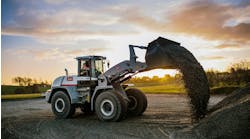Electrohydraulic System Improves Material Handler Performance
Caterpillar Inc. continues to expand its line of Next Generation machines featuring advanced technologies. The Cat MH3050 material handler is the latest addition to this product line, featuring an electrohydraulic system which helps optimize efficiency and cycle times.
According to Rich Knudson, product application specialist at Caterpillar Inc., the electrohydraulic system is at the center of many of the company’s Next Generation machines. It enables Caterpillar engineers to completely integrate the machine’s key systems for greater efficiency and productivity, he said in an interview with Power & Motion. “It also provides the operator the ability to tailor the hydraulic system to the response, control, and power he or she prefers.”
Electrohydraulic Systems Offer Potential to Improve Efficiency
When Caterpillar first introduced its Next Generation concept in 2017 – starting with its hydraulic excavators – the company’s goal was to meet evolving customer needs for improved productivity, efficiency, and ease of operation. In addition, it recognized the growing use of digital technologies such as automated systems.
To help meet these requirements, the company chose to standardize use of an electrohydraulic system featuring an electrohydraulic control valve and electronically controlled pump. Incorporation of electronics enables the hydraulics to operate in a more precise and controlled manner, leading to more efficient operation. This helps to reduce energy, and thus fuel, use in a machine, lowering operating costs for machine owners among other benefits.
Knudson explained the use of electrohydraulics enables immediate flow through the system upon command which aids efficiency improvements. This also helps operators to tailor hydraulic system performance to their application requirements, in turn increasing operator efficiencies and reducing cycle times he said.
With the inclusion of an electrohydraulic system on the material handler, advanced technologies like Caterpillar’s SmartBoom can be incorporated as well. This technology allows the machine’s boom to travel up and down without using hydraulic pump flow while enabling operators to focus their attention on controlling the stick and grapple which the company said allows for a more fuel-efficient work cycle.
How Electrohydraulics Benefit Machine Performance
Electronically controlling the material handler’s hydraulics brings a range of performance benefits. For instance, it allows for the incorporation of more sensors around the machine to aid with various functions. For instance, position sensors at the end of the stick make it easier to know the exact position of the stick so operators can move it accordingly based on the task at hand.
Knudson said the MH3050 is equipped with boom, stick and swing position sensors which allow e-fencing, cab avoidance and Cat Payload measurement to now be standard features on the material handler. With these advanced technologies, the machine can be operated in a safe and productive manner.
E-fence, for example, allows operators to preset the working area, and places to avoid, from a monitor within the cab. The machine is kept within this set boundary area, preventing operators from moving the machine outside of it and thus causing potential safety issues.
Features like this are possible because of the electronics incorporated into the hydraulics and other machine systems as they allow communication between systems and better control.
Inclusion of an electrohydraulic system on the material handler enabled Caterpillar to implement joystick steering, which is becoming increasingly more commonplace in the heavy equipment market. This type of steering eliminates use of a steering wheel, improving visibility and space within the cab.
Signals for the joystick are sent via an electrical connection to the material handler’s electronic control module (ECM) which helps to simplify the machine design. Typically, the steering system requires hydraulic lines and filters running from the elevated operator cab to the main hydraulic valve. However, this was removed in the MH3050 because of the ability to use electrohydraulics and joystick steering.
“This update simplifies the whole system, reduces maintenance parts with the removal of the pilot lines and allows endless tuning possibilities,” he said. “The machine can be fine-tuned to individual operator preferences and those can be saved.”
Knudson said another benefit of removing the traditional hydraulic steering system is the reduction of heat and noise generation in the cab which helps operators to be more comfortable and productive during the workday. In addition, he said operators have told Caterpillar the new system design “provides smoother operation and excellent controllability while using combined functions [of the] boom, stick, grapple open & close, and swing.”
Continued Growth of Electrohydraulic Systems
Use of electrohydraulics will continue to increase as more electronics are incorporated into machines and customers request the efficiency, precision and control which can be achieved.
“Electrohydraulic systems are becoming more prevalent in heavy equipment as they enable more efficient machine operation, lower owning and operating costs, and are the vehicle for integrated productivity tools such as payload [measurement] and e-fencing,” said Knudson.
READ MORE: Increased Demand for Electronic Controls Driving Hydraulic System Designs
Growing efforts to automate functions, systems and eventually full machines will help drive this as well.
Knudson said electronic control of hydraulic systems and integration of sensors on machines will allow further development and upgrading of machine functionalities, enabling even more performance enhancements. “This will include technologies already available on other earthmoving excavators like remote control capabilities and assist functions for repetitive cycle operation,” he concluded.
